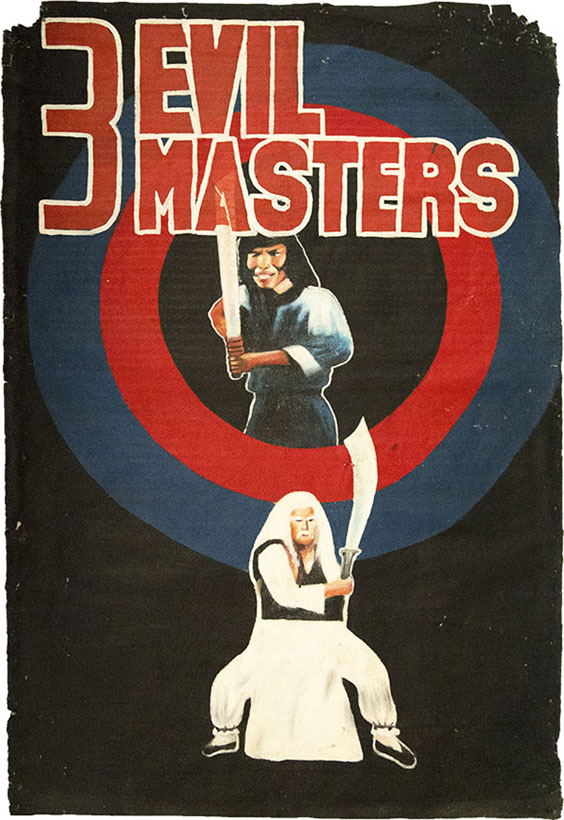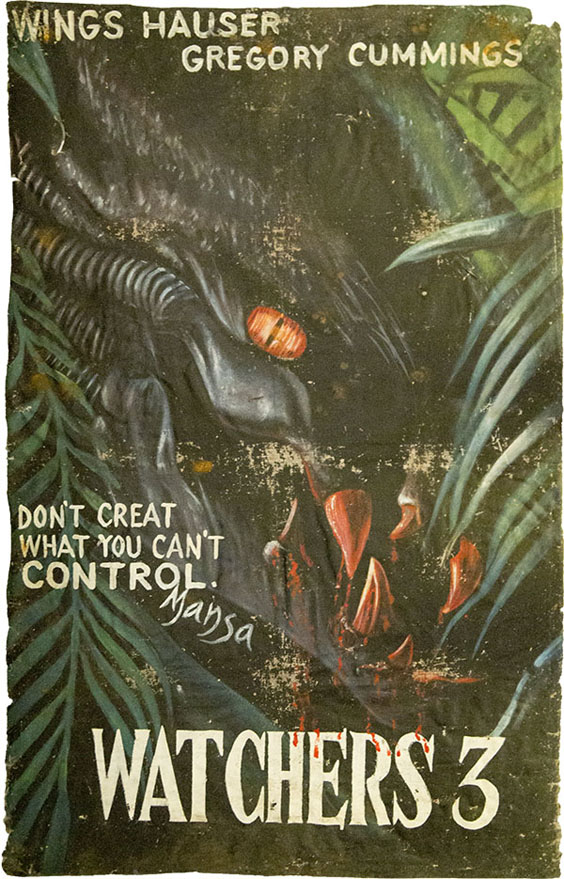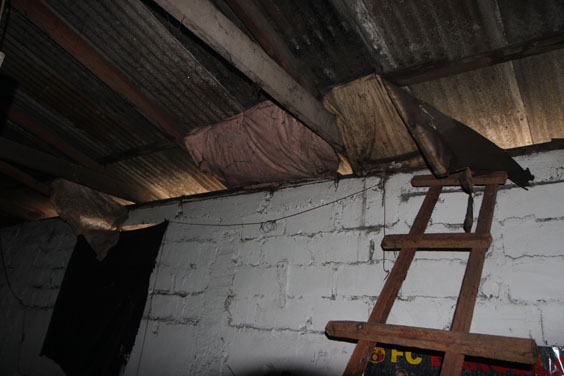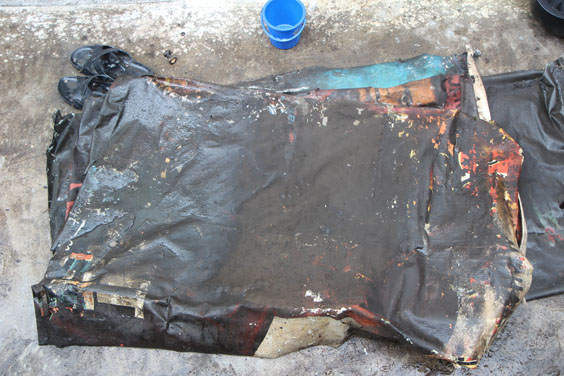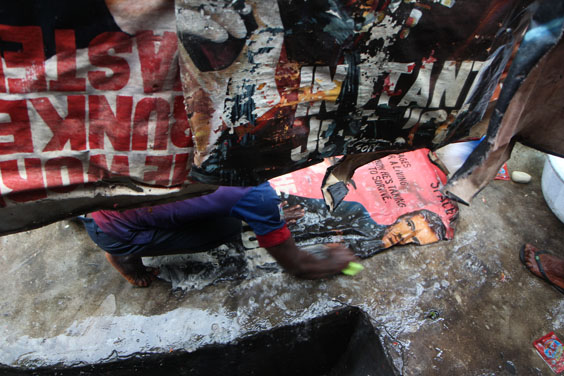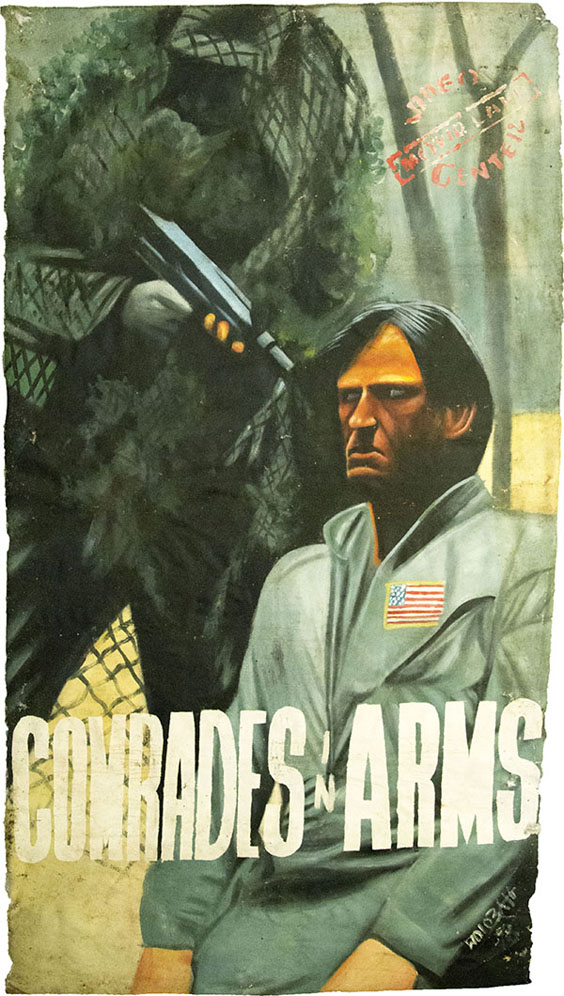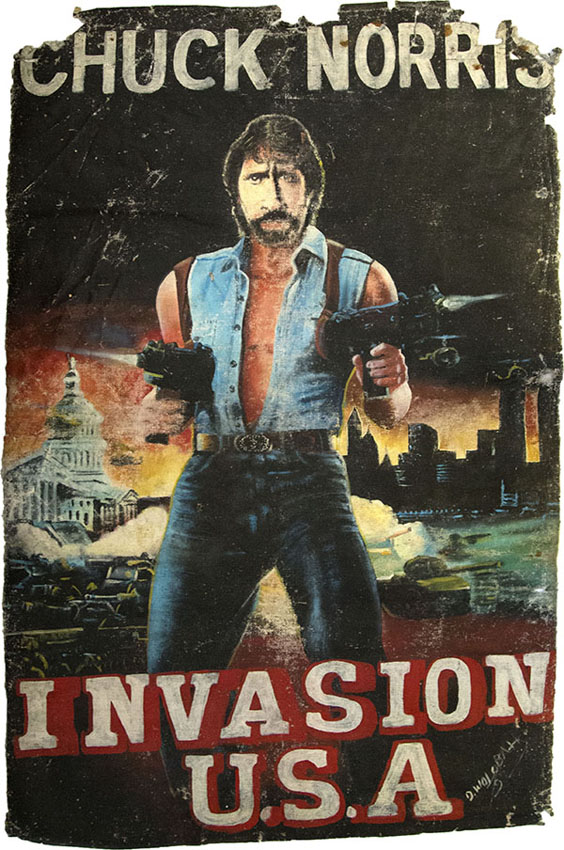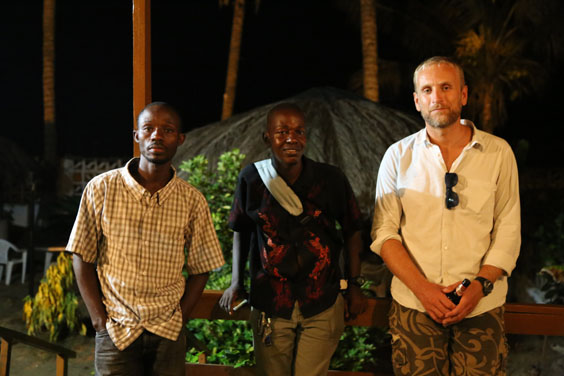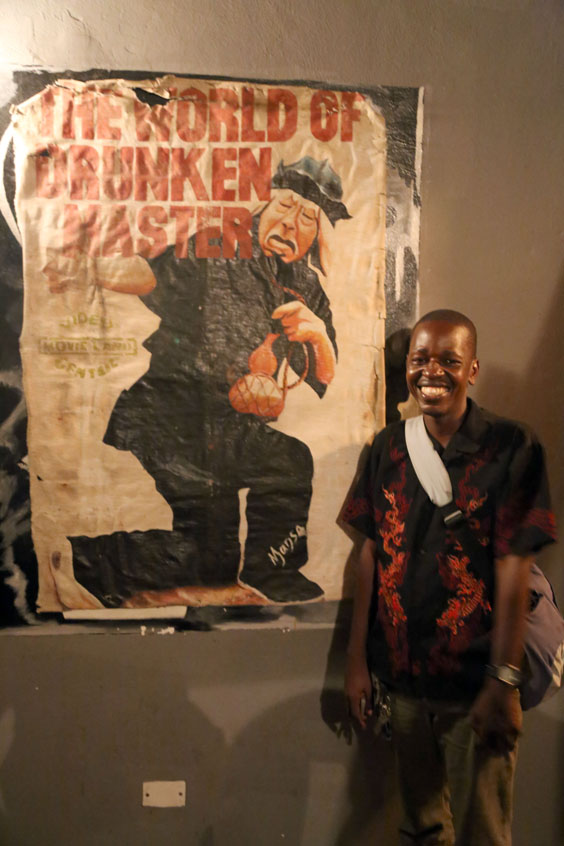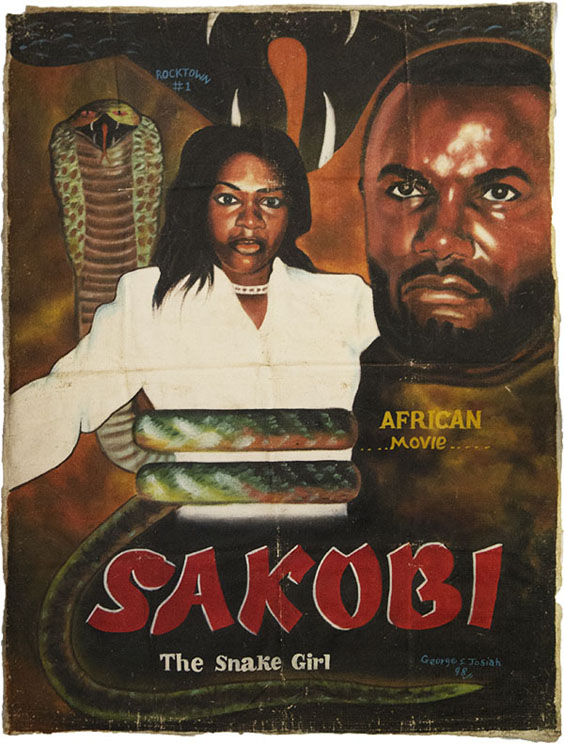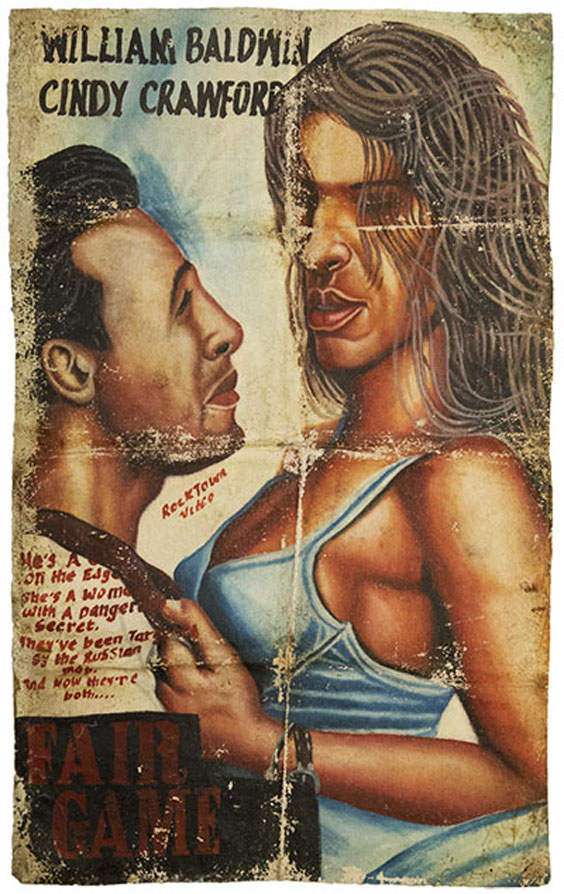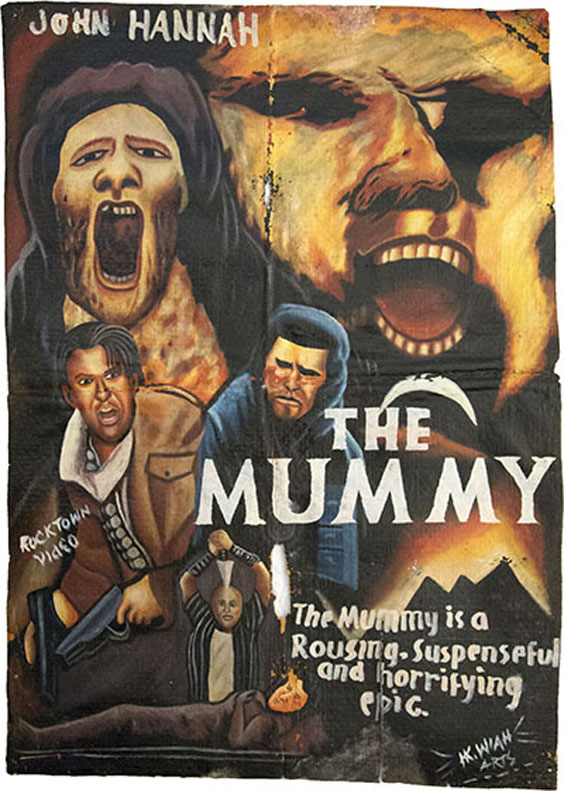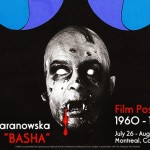FROM THE ATTIC TO THE GALLERY: EXCAVATING LIBERIAN POSTER ART
Until the early 2000s, Liberia’s local cinemas operated outside of an official distribution circuit and projected films from VHS copies. For their promotional campaigns, cinemas would solicit local painters to create movie posters based on the VHS viagra professional scam covers. Thousands of these posters were created – and then lost. That is, until a curious French visitor named Francois Beaurain began looking for the posters and unearthed the history of an unintentional art movement.
His findings have been collected for a gallery exhibition at Paris’ Cinéma des Cinéastes (7 Avenue de Clichy) that began with an opening vernissage on March 4th and runs until April 10th. Here, Esinam Beckley talks to Beaurain about his discoveries, and their traversal from a rundown cinema being used as insulation to a gallery space over 4,000 miles away.
Esinam Beckley: How did you first start collecting the hand painted posters/ what was it that sparked your interest in them?
Francois Beaurain: In Liberia, I was making collages with Nigerian buy cheapest viagra online movie (Nollywood) posters. One day I showed my work to a friend of mine in Paris. My collages reminded her about a Ghanaian movie posters exhibition that was held in Musee Quai Branly a few months before. When I got home I looked on the internet and discovered the Ghanaian movie order cialis online without prescription posters. It really sparked price of propecia from canada my interest. I was completely fascinated by these posters and thought ” maybe there’s something like that in Liberia too, I should have a look”. When I came a few weeks later to Liberia, I started to look around but in vain. A friend of mine put me in contact with a painter, who used to make these posters. The painter contacted the theaters who use to order him posters and this is how it started.
EB: Did you have experience before this in art collecting?
FB: No, never. I never collected art in my life. This is really my first experience. It took me a long time to find the posters. It was really difficult because it was really messy. You call somebody who knows somebody that knows somebody etc… It took three months before I could find the first batch of posters in a former theater now only showing soccer games. It was the former owner of that theater who told me he left some posters in the attic. We went there a first time but we did not find anything.
We came a second time, and we discovered that the posters were not exactly in the attic. They were nailed to the roof to make the theater light proof. After the years, they were covered by dust and current owner never really understood what is was. In this first theater there were 25 posters, that was the biggest batch I found. The quest lasted for one year, I was going from one theater to another asking for posters. Most people never heard about painted posters. In a country where most population is under 25, 15 years is already a long time. There were also the theaters where they knew about the posters but admitted that after the years they had to dump them.
EB: How did you end up in Liberia in the first place?
FB: My girlfriend works for a humanitarian organization which sent her to Liberia for a 18 months contract. My job was ending in Paris, so I decided to go there to live with her this African experience. In Liberia I did some consulting activities but also spent a lot of time working on my own artistic activities like collages, animated gifs and sculptures out of decommissioned weapons. I rapidly understood that searching posters randomly (going from one theater to the other) was useless but that the easiest was to find the painters first. The painters were then calling the theaters for me to arrange the first meeting. Slowly I became friends with the painters and they started to tell me their stories and the story of these posters. In the 90’s, Liberia had a hundred theaters consisting of a room with a TV and VHS. There were no paper posters, so the theaters were ordering the posters to the painters. It took one or two days for the painter to copy the VHS cover to a 4’ by 3’ canvas. Painters were earning something like 10$ for a poster. According to local standards, it was quite a good job, and there was a lot of work. All this stopped at the end of the 90’s. I am not sure if it is because of the civil war or because of the Nigerian film industry (Nollywood) arriving in Liberia. However, with Nollywood and its DVDs, there were no need anymore for painters.
EB: What are a few differences between the Ghanaian and Liberian posters?
FB: There are several differences. The Ghanaian posters are from the 80s, and they were made for mobile cinemas going from one village to the other. The posters were made on rice bags (made up of cotton at that time). The posters from Liberia are painted on plasticized cloth, like the one you would put on a table and they are from the 90’s. But the biggest difference relies in the style. Ghanaian posters are more naive than Liberian ones. There is less room for interpretation in the Liberian way of doing movie posters. Why? I do not really know, maybe just because in Liberia the job was done by trained painters who knew about copying techniques.
EB: What do you think personally it is about these posters people find so fascinating? What is the draw to this particular style?
FB: Why are they so fascinating? That’s a good point. I think these posters are a funny mirror of our entertainment industry. A movie industry like Hollywood is a huge machinery spending million dollars in communication and marketing. This is a world where famous actors are products with a quote and actors pay a lot of attention to their appearance. These posters give to the contrary a total different look to the star system. The way the famous actors are depicted look like caricatures. With their naivety, these posters give us a fresh look to these movies and this industry and reminds us that it is just entertainment.
EB: Have you talked to the artists themselves? What do they think of the work?
FB: I’ve met personally two painters, Mansa and Georges, who most of the posters I own. They became friends of mine. They were a little bit surprised that I had interest for these posters. For them, the movie posters were not meant to be art. It was just a good job, a way to make quick money. It was something they were doing in parallel to their own artistic practice. They were doing more traditional things that they considered as real artwork.
EB: Out of your collection do you have a particular favourite, and why?
FB: I have several favorite ones. Pictorially, my favorite is ”The Buddhist Fist”. I like the way the painter dealt with the color and avoided to go into the details. Indeed, both Mansa and Georges explained me that they had to work fast and for that they developed a proper style. In the Buddhist fist, Georges excels by its minimalist style where faces is made of just a few “traits”. My other favourite one is “Sakobi” the only African movie from the collection. It is a precursor of the huge Nigerian movie boom that was in preparation at that time. Which one is your favourite?
EB: I like Fair Game – it was a very bad movie with Cindy Crawford. On the poster she looks so vulgar. The poster makes it lose the fake draw of the sexy woman. The face is so brutal.
FB: Yes, this one is closer to the Ghanaian style and that one is not signed so I don’t know who did that one. Funny story about Georges Josiah one of the two painters I met. He’s still painting but does not consider himself a painter. With the money he made as a painter in Liberia he is building churches!

 March 5, 2015
March 5, 2015  No Comments
No Comments
